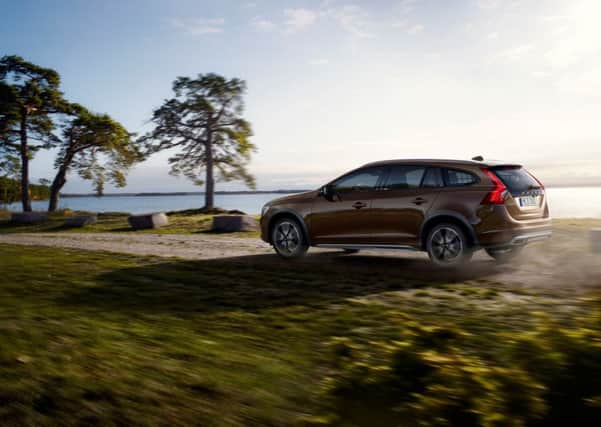V60 Cross Country is at home in wilds and Autobahn


This year’s XC90 is in the vanguard, followed soon by the S90 saloon and in 2017 a new small car.
Back to now. We were on our way to France in a Toyota. A couple waved us over to their table. They were caravanners and had wisdom they needed to share with someone. He had driven BMWs in his job on the road but had chosen a Volvo V60 as retirement car because it was substantially heavier than the relevant BMW and its weight gave, he said, a better tow. They still missed their BMW as an everyday drive.
Advertisement
Hide AdAdvertisement
Hide AdA Volvo V60 Cross Country won its class last year in the Caravan Club towing awards.
This summer, in the latest awards, the Volvo was displaced in its class (£30,000 to £40,000) by a VW Passat Estate GT. The overall winner was the Land Rover Discovery HSE LUX.
My father and his best friend, now hitching up in the heavens, used Volvos for towing – in those days the rear-wheel-drive, brick-shaped saloons. That’s enough towing for this month. I didn’t do any of that with the V60. I just drove it, as the majority of caravanners will do, unhitched and with enjoyment.
The initial V in V60 means it’s an estate car in the Volvo lexicon, akin to the Avant model in the world of Audi’s A4 Allroad. A completely new version of that is expected next spring. Volvo’s 4x4 D4 Cross Country is fitted with five-cylinder, 187.3bhp, 2.4-litre diesel engine with a six-speed automatic gearbox, which Volvo calls Geartronic – aka Tiptronic, as developed by Porsche in the beginning.
Being a Cross Country model, it has increased ground clearance – which if your inside leg measurement is 30-inch or under means you may be scuffing your clothes on the sill as you step out of the cab.
Prices for the front-wheel-drive model start at £30,195 for the 148bhp diesel D3 SE. You pay £31,660 for the SE with the bigger engine. The 4x4 models with this 2.4-litre engine and slightly higher torque and manual gears in SE trim are £33,190. As tested, in Lux trim with automatic gears and navigation, it costs from £38,025, so you are probably towing something like a plush Bailey or Elddis.
The total cost of the car tested was £44,000, which brings some things you might consider should be standard on a £38,000 car, albeit with leather-faced seats and the navigation as standard.
The £1,900 Driver Support Pack has automatic braking, pedestrian and cyclist detection, adaptive cruise control and blind spot monitoring. The £675 Winter pack includes heated front seats and windscreen, active bending Xenon lights with cleaners and auto dimming mirrors; the £700 security pack adds laminated windows which resist break-ins, keyless entry and push-button ignition, water repelling front side windows and a “personal car communicator”, which is Volvo-speak for a smart key fob which closes or open windows from a distance.
Advertisement
Hide AdAdvertisement
Hide AdThe metallic paint was £925. Another £850 went on a small sunroof, £500 on a hi-fi upgrade and among the other extras was £150 for a slim spare wheel and jack.
The navigation system needed remapping, being confusing to the point of leading me into errors and possible dangerous dithering at some junctions, following roads which were changed years ago.
Apart from that, the Volvo instrumentation is as good as it gets for me. It is intuitive and the layout is attractive, with clear graphics and switchable layouts linked to the driving mode chosen. The storage behind the centre stack is useful.
The new engine gives serious acceleration, with a 0-62mph time of 8.1 seconds. Top speed is 124mph – something which is not important in this country but shows off its potential pace to the fast-moving drivers on the German motorways.
On paper, fuel consumption looks promising, with a quoted average of 49.6mpg and 149g of CO2. On test it averaged 33mpg to 35mpg on the trip computer – with a consequent increase in emissions. Coaxing it on an unimpeded journey at moderate speeds recorded 40mpg.
The boot’s luggage area is modest but extends along a flat floor when the seats are lowered. The car’s gravitas can be sensed in the effort needed to lift the rear seats back into the vertical position. Twenty reps of that and you’ve had a good upper body work-out.
STATS
It is: Volvo V60 Cross Country. Rough-road-ready version of the V60 estate with front-wheel drive or 4x4 traction on a slightly raised chassis with some body protection. Choice of D3 2-litre and D4 2.4-litre diesel engines.
Prices: From £30,195 for the D3 SE.
Model tested: The D4 All Wheel Drive with automatic gears, from £38,025.
Advertisement
Hide AdAdvertisement
Hide AdFor: Good performance but economy suffers, with around 34mpg in normal driving on the trip computer.
Against: Thirsty. Excessive tyre drumming heard from the Michelin Primacy summer tyres.
Towing: Braked trailer weight is 1,800kg